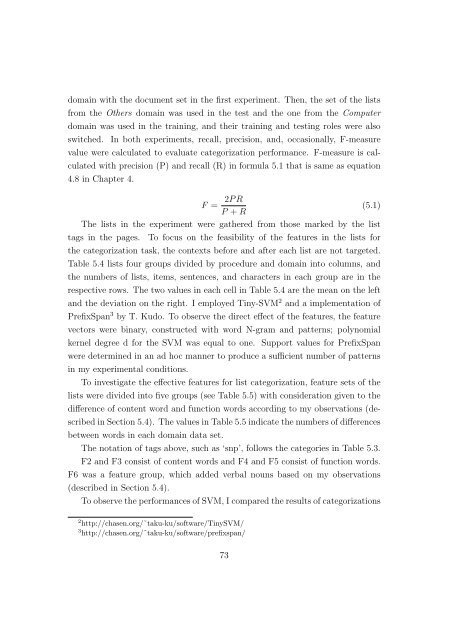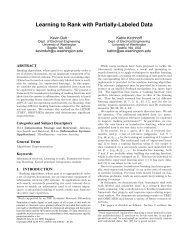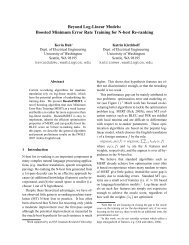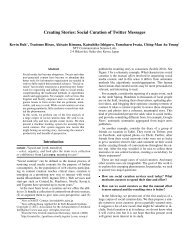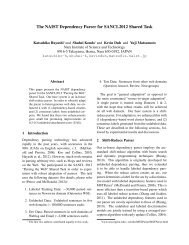file - ChaSen - 奈良先端科学技術大学院大学
file - ChaSen - 奈良先端科学技術大学院大学
file - ChaSen - 奈良先端科学技術大学院大学
- No tags were found...
Create successful ePaper yourself
Turn your PDF publications into a flip-book with our unique Google optimized e-Paper software.
domain with the document set in the first experiment. Then, the set of the listsfrom the Others domain was used in the test and the one from the Computerdomain was used in the training, and their training and testing roles were alsoswitched.In both experiments, recall, precision, and, occasionally, F-measurevalue were calculated to evaluate categorization performance. F-measure is calculatedwith precision (P) and recall (R) in formula 5.1 that is same as equation4.8 in Chapter 4.F = 2P R(5.1)P + RThe lists in the experiment were gathered from those marked by the listtags in the pages.To focus on the feasibility of the features in the lists forthe categorization task, the contexts before and after each list are not targeted.Table 5.4 lists four groups divided by procedure and domain into columns, andthe numbers of lists, items, sentences, and characters in each group are in therespective rows. The two values in each cell in Table 5.4 are the mean on the leftand the deviation on the right. I employed Tiny-SVM 2 and a implementation ofPrefixSpan 3 by T. Kudo. To observe the direct effect of the features, the featurevectors were binary, constructed with word N-gram and patterns; polynomialkernel degree d for the SVM was equal to one. Support values for PrefixSpanwere determined in an ad hoc manner to produce a sufficient number of patternsin my experimental conditions.To investigate the effective features for list categorization, feature sets of thelists were divided into five groups (see Table 5.5) with consideration given to thedifference of content word and function words according to my observations (describedin Section 5.4). The values in Table 5.5 indicate the numbers of differencesbetween words in each domain data set.The notation of tags above, such as ‘snp’, follows the categories in Table 5.3.F2 and F3 consist of content words and F4 and F5 consist of function words.F6 was a feature group, which added verbal nouns based on my observations(described in Section 5.4).To observe the performances of SVM, I compared the results of categorizations2 http://chasen.org/˜taku-ku/software/TinySVM/3 http://chasen.org/˜taku-ku/software/prefixspan/73


